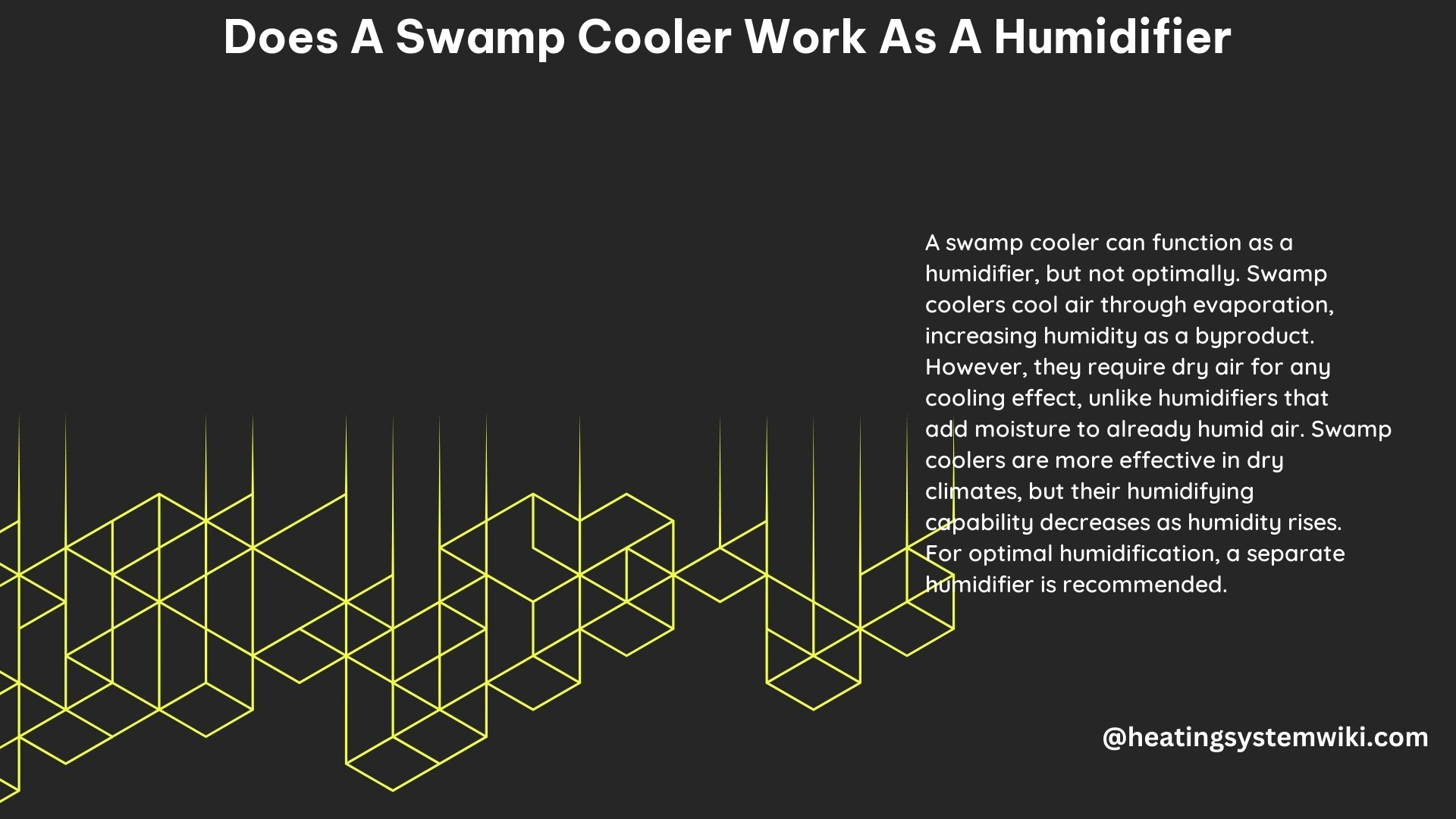A swamp cooler, also known as an evaporative cooler, can work as a humidifier by adding moisture to the air through the process of evaporation. Swamp coolers use a fan to draw hot, dry air from outside and pass it through a wet pad, causing the water to evaporate and the air to cool. As a byproduct of this process, the air also becomes more humid.
Understanding the Functionality of Swamp Coolers
Swamp coolers work by using the heat from the air to evaporate water, which cools the air and adds moisture. The efficiency of a swamp cooler depends on the temperature and humidity of the outside air. The hotter and drier the air, the more efficiently the swamp cooler will work.
Factors Affecting Swamp Cooler Efficiency
- Temperature: Swamp coolers are most effective in hot, dry climates where the outside air temperature is high. The higher the temperature, the more efficiently the water will evaporate, leading to greater cooling and humidification.
- Humidity: In dry climates with low relative humidity, swamp coolers can add significant amounts of moisture to the air. In more humid climates, the swamp cooler will still add some humidity, but the effect will be less pronounced.
- Air Flow: The fan in a swamp cooler draws in hot, dry air and passes it through the wet pad. The faster the air flow, the more efficient the evaporation process will be, leading to greater cooling and humidification.
Comparison to Humidifiers
In contrast to swamp coolers, humidifiers work by adding moisture directly to the air, without relying on the heat from the air to evaporate the water. Humidifiers can be more effective in humid climates, where the air already has a high moisture content, and they typically require less maintenance than swamp coolers.
Installation and Maintenance Considerations

Swamp coolers and humidifiers have different installation and maintenance requirements.
Swamp Cooler Installation and Maintenance
- Location: Swamp coolers are typically installed outside, on the roof or near the foundation of a building, to draw in hot, dry air from the outside.
- Maintenance: Swamp coolers require regular maintenance to clean and replace the wet pads, which can become clogged with mineral deposits and debris over time.
- Water Supply: Swamp coolers need a constant supply of water to keep the wet pads moist, which may require the installation of a water line or a water storage tank.
Humidifier Installation and Maintenance
- Location: Humidifiers are typically installed inside the home, often near the HVAC system, to add moisture directly to the indoor air.
- Maintenance: Humidifiers generally require less maintenance than swamp coolers, as they do not have wet pads that need to be replaced.
- Water Supply: Humidifiers may be connected to a water line or use a water tank that needs to be refilled periodically.
Swamp Cooler Sizing and Capacity
Swamp coolers are available in a range of sizes and capacities, from small portable units to large central systems.
Portable Swamp Coolers
- Cooling Capacity: Portable swamp coolers typically have a cooling capacity of 1-2 tons, which is sufficient for cooling small to medium-sized rooms.
- Features: Portable swamp coolers often include adjustable fan speeds, programmable timers, and remote controls for convenient operation.
Central Swamp Cooler Systems
- Cooling Capacity: Central swamp cooler systems can have a cooling capacity of up to 5 tons, making them suitable for cooling larger homes or commercial spaces.
- Installation: Central swamp coolers are typically installed on the roof or near the foundation of a building and require ductwork to distribute the cooled and humidified air throughout the space.
DIY Swamp Cooler Construction
If you’re interested in building your own swamp cooler, there are a few key considerations:
- Determine the Size and Capacity: Assess the size of the space you want to cool and choose a swamp cooler with the appropriate cooling capacity.
- Select the Location: Decide whether you want to install the swamp cooler inside or outside the building, and plan for any necessary ductwork or vents.
- Gather the Materials: You’ll need a fan, a water pump, a wet pad, and a housing to contain the components. You can use a variety of materials, such as wood, plastic, or metal, to build the housing.
- Install the Water Supply and Drainage System: Ensure that the wet pad stays moist by installing a reliable water supply and a drainage system to prevent water overflow.
- Test and Maintain the Swamp Cooler: Once the swamp cooler is assembled, test it thoroughly to ensure it’s working correctly. Regular maintenance, such as cleaning the wet pad and checking the water supply, is essential for optimal performance.
Building your own swamp cooler can be a rewarding DIY project, but it’s important to carefully plan and execute the construction to ensure the unit is safe and effective.
References:
– Evaporative Cooler or Humidifier?
– Swamp Cooler and Humidifier in One System
– Ultrasonic Humidifier as Evaporative Cooler
– The Relationship Between Evaporative Coolers and Humidifiers
– Evaporative Humidifier vs Swamp Cooler for Adding Moisture
